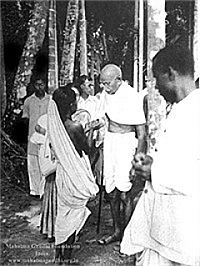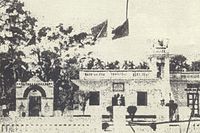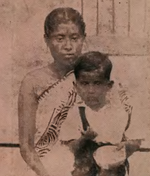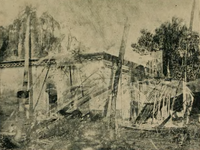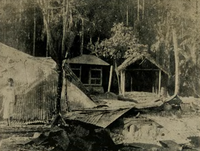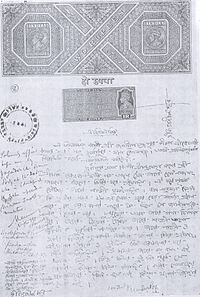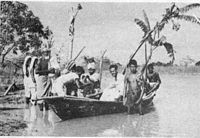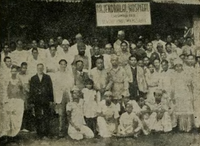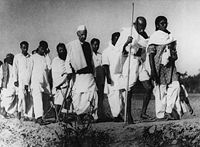- Noakhali genocide
-
Noakhali genocide (Bengali: নোয়াখালী গণহত্যা) also known as the Noakhali Carnage was a series of massacres, rapes, abductions and forced conversions of Hindus and loot and arson of Hindu properties, perpetrated by the Muslim community in the districts of Noakhali[N 1] and Tipperah[N 2] in the Chittagong Division of Bengal in October–November 1946, an year before India's independence from British Rule. It affected the areas under the Ramganj, Begumganj, Raipur, Lakshmipur, Chhagalnaiya and Sandwip police stations in Noakhali district and the areas under Hajiganj, Faridganj, Chandpur, Laksham and Chauddagram police stations in Tipperah district, a total area of more than 2,000 square miles.
The massacre of the Hindu population started on 10th October, on the day of Kojagari Lakshmi Puja and continued unabated for about a week. It is estimated that over 5,000 Hindus were killed,[1][2] hundreds of Hindu women were raped and thousands of Hindu men and women were forcibly converted to Islam.[3] Around 50,000 to 75,000 survivors were sheltered in temporary relief camps in Comilla, Chandpur, Agartala and other places.[4] Apart from that around 50,000 Hindus remained marooned in the affected areas were under the strict surveillance of the Muslim hooligans, where the administration had to say.[4] In some areas the Hindus had to obtain permits from the Muslim leaders in order to travel outside their village. The forcibly converted Hindus were coerced to give written declaration that they have converted to Islam on their own free will. Sometimes they were confined in houses not their own and only allowed to be in their own house, when an official party came for inspection. The Hindus were forced to pay subscription to the Muslim League and pay jiziyah, the protection tax paid by zimmis in an Islamic state.[5]
Haran Chandra Ghosh Choudhuri, the only Hindu representative to Bengal Legislative Assembly from the district of Noakhali described the incidents as the organized fury of the Muslim mob.[6] Syama Prasad Mookerjee, the former Vice-Chancellor of the University of Calcutta and the former Finance Minister of Bengal, dismissed the argument that the Noakhali incidents were ordinary communal riots. He described the events as a planned and concerted attack by the majority community on the minority community.[4]
Mohandas Gandhi, camped in Noakhali for four months and toured the district in a mission to restore peace and communal harmony. However, the peace mission failed to restore confidence among the survivors, who couldn't be permanently rehabilitated in their villages. In the meanwhile, the Congress leadership accepted the Partition of India and the peace mission and other relief camps were abandoned. Majority of the survivors migrated to West Bengal, Tripura[7] and Assam.[8]
Contents
Background
Demography of Noakhali Sadar sub-division[9] Police Station Villages Muslims (%) Hindus (%) Raipur 45 89.17 10.46 Lakshmipur 215 84.70 15.28 Ramganj 238 69.83 30.16 Begumganj 317 79.38 20.60 Senbag 98 83.58 15.21 Sudharam 212 84.49 15.13 Companyganj 22 83.56 16.44 Ramgati 27 91.03 8.97 Hatia 23 82.29 17.69 Sandwip 49 78.19 21.81 The districts of Noakhali and Tipperah lay in the south eastern corner of Bengal, in the division of Chittagong and bordering the princely state of Hill Tippera. The district of Noakhali constituted of two sub-divisions Sadar and Feni covered a total area of 1,658 square miles. Noakhali was situated on the eastern bank near of Meghna near its confluence and therefore included in its domain several river islands, known as chars in Bengali, the Sandwip and Hatia being the largest two of such islands. Mainland Noakhali itself was crisscrossed by a network of small rivers and canals. The economy was mainly agrarian, with extensive plantations of jute, betel, betel nuts and coconuts. Given the physiographic nature of the district, country boats were the primary means of transport with hardly any motorable roads in the district. A metre gauge railway connecting Comilla and Chittagong ran through Feni, branching off at Laksham to connect Noakhali town.
Muslims constituted 80.57% of the population in Noakhali to 19.31% Hindus, reflecting a demographic pattern characteristic of the districts of eastern Bengal, where the Muslims were in overwhelming majority. Agriculture being the economic mainstay of the region, a majority of the population, Hindus and Muslims alike were cultivators, majority of them sharecroppers and landless agricultural labourers. Apart from agriculture, the Hindus were engaged in handloom, banking and small businesses. The educated Hindu gentry were white collared job holders, mainly teachers, lawyers and doctors, some of them small landowners.
Direct Action Day
Main article: Direct Action DayIn 1940, the Muslim League raised the Pakistan proposal at its Lahore convention, that envisaged a Muslim homeland in British India, consisting of the provinces where the Muslims were in a majority, including Bengal. In the 1946, the Muslim League contested the elections on the plank of Pakistan, and an overwhelming 97% of the Muslim population of Bengal voted for Muslim League.
The Muslim League refused to accept the Cabinet Mission plan and join the Interim Government. Instead it resolved to embark on ‘direct action’ in order to achieve Pakistan. The Muslim League decided to observe Direct Action Day on 16th August 1946. In Bengal, the only Muslim League ruled province in British India, the day was declared a public holiday. Kolkata witnessed an unprecedented mass violence in the next five days, leaving 4,000 dead according to official reports. The Direct Action Day was simultaneously observed in the district towns of Bengal, most notably in Dhaka where Hindu properties were looted and Hindus murdered. The situation in the districts of eastern Bengal became tense, and sporadic acts of violence against the Hindu minority were reported from places like Mymensingh and Narayanganj.
Prelude
Noakhali did not witness any violence during the Great Calcutta Killings. Though it was quiet the tension was building up. The Eastern Command Head Quarters in Kolkata received reports, indicating tension in the rural areas of Noakhali and Chittagong districts, a week after the Great Calcutta Killings, six weeks before the genocide in Noakhali.[10] The situation quickly escalated into violence on the day on Id-ul-Fitr. From 2nd October onwards there were frequent instances of stray killings, snatching and looting.[11]
Id-ul-Fitr riots
Although there were no major incidents in Noakhali during the Kolkata riots, the district remained tense. On 29 August, the day of Id-ul-Fitr, a rumour spread that Sikhs, hired by Hindus were killing the Muslims en masse. Muslims mobs the suburban mosques from poured into the Noakhali town and resorted to loot and arson. Incidents of waylaying and murder of Hindus took place in the roads and waterways.
A group of Hindu fishermen were attacked with deadly weapons while fishing in the Feni river. One of them was killed and two seriously injured. Another group of nine Hindu fishermen from Charuriah were severely assaulted with deadly weapons. Seven of them were admitted to hospital.[6] Devi Prasanna Guha, the son of a Congressman of Babupur village under Ramganj police station was murdered.[12] One of his brothers and a servant was assaulted. The Congress office in front of their house was set on fire.[6] Chandra Kumar Karmakar of Monpura was killed near Jamalpur. Jamini Dey, hotel worker was killed near Ghoshbag. Ashu Sen of Devisinghpur was severely beaten up at Tajumiarhat at Char Parvati. Rajkumar Choudhury of Banspara was severely assaulted on his way home.[6]
In Chandraganj, the shops of Kamini Kumar Pal and Jadav Chandra Saha were looted. The latter was beaten up. The Hindu-owned shops of Koresh Munshi Hat were looted. At Bholakot, three boats full of clothes were looted. Hindu-owned shops including two pharmacies were looted in Kankirhat. The Hindu shopkeepers of Tajmohammad Hat were driven away. Some Hindu shops of Sahapur market were looted. At Sonapur market, the shop of Subal Chandra Banik was looted.[6]
All the properties of six or seven Hindu families of Kanur Char were looted. At Karpara, a Muslim gang armed with deadly weapons entered the house of Jadav Majumdar and looted properties worth Rs. 1,500. Nakul Majumdar was assaulted. The houses of Prasanna Mohan Chakraborty of Tatarkhil, Nabin Chandra Nath of Miralipur and Radha Charan Nath of Latipur were looted. Five members of the Nath family of Latipur were injured.[6]
The temple of the family deity of Harendra Ghosh of Raipur was desecrated. A calf was butchered and thrown inside the temple. The Shiva temple of Dr. Jadunath Majumdar of Chandipur was desecrated in a similar manner. The household shrines of Nagendra Majumdar and Rajkumar Choudhury of Dadpur were desecrated and the idols were stolen. The Durga images of Ishwar Chandra Pathak of Kethuri, Kedareshwar Chakraborty of Merkachar, Ananta Kumar De of Angrapara and Prasanna Mohan Chakraborty of Tatarkhil were broken.[6]
Communal propaganda
In 1937, Gholam Sarwar Husseini the scion of a Muslim pir family had got elected to the Bengal Legislative Assembly on a Krishak Praja Party ticket. However, in the 1946 elections, he got defeated to a Muslim League candidate. Gholam Sarwar's father and grandfather were pious Muslims and had led lives of penance. Their family happened to be the hereditary khadims at the Diara Sharif in Shyampur, revered as a holy place by Muslims and Hindus alike. After the Direct Action Day riots in Kolkata, Husseini began to deliver provocative speeches, inciting the Muslim masses to take revenge of the Kolkata riots.[13][14] In some places Hindu shops were began to be boycotted. In the Ramganj and Begumganj police station areas, the Muslim boatmen refused to ferry the Hindu passengers.[14] In the first week of September, the Muslim miscreants looted the Hindu shops in Sahapur market.[14] The Hindus were harassed and molested when they were returning to their native villages from Kolkata to spend the Puja holidays.[14]
Events
On 10 October, the day of Kojagari Lakshmi Puja, when the Bengali Hindus were busy in puja activities, the Muslim League leadership started a false rumour that the Sikhs had attacked Diara Sharif.[15] As the rumour spread Muslims from the surrounding areas began to assemble at the Diara Sharif. Ghulam Sarwar instructed the Muslim masses to march towards the Sahapur market. Another Muslim League leader Kasem too arrived at the Sahapur market with his private army, then known as Kasemer Fauz.[N 3] The shrine of Kali was desecrated and the Hindu shops were looted. The Muslim mob began to shout anti-Hindu slogans.
After that Kasem's army marched to Narayanpur to the zamindari office of Surendranath Basu. Kasem's army was joined their by another Muslim mob from Kalyannagar. Some of the Muslim tenants too joined the mob and attacked the zamindari office. After a brief resistance Surendranath Basu was critically wounded by a sharp weapon. The Muslim mob tied his hands and legs burned him alive.[15] On hearing that Surendranath Basu had been attacked, Rajkumar Pal, a doctor from the nearby village of Panchgharia set out to rescue him. But he was stabbed by a miscreant on the way.[16]
On 11 October, the private army of Gholam Sarwar, known as the Miyar Fauz attacked the residence of Rajendralal Roychowdhury, the president of the Noakhali Bar Association and the Noakhali District Hindu Mahasabha. At that time Swami Tryambakananda of Bharat Sevashram Sangha was staying at their house as guest. Rajendralal defended the mob from his terrace with his rifle for the entire day. At the nightfall, when the mob retreated Rajendralal sent the Swami and his family members to safety. The next day the mob attacked again. The set fire to the house and killed 22 family members including Rajendralal's elder brother Chintacharan and younger brother Satish and himself.[17] The severed head of Rajendralal Roychowdhury was presented to Golam Sarwar on a platter and his two daughters were gifted to two of his trusted generals.[18] According to Sucheta Kriplani, Rajendralal Roychowdhury had followed the footsteps of Shivaji and Guru Gobind Singh and became a martyr, defending his faith and family honour.[19] Acharya Kripalani, a staunch believer in non-violence, held that the resistance offered by Rajendralal Roychowdhury and his family, was the nearest approach to non-violence.[19] After three months Mohandas Gandhi while touring Noakhali visited their gutted house. On 11 January 1947, the corpses of the Roychowdhurys were exhumed from a swamp in Azimpur and brought before Mohandas Gandhi's prayer assembly at Lamchar High School. After the prayers the corpses were cremated according to Hindu rites.
On 12 October, the residence of Chittaranjan Dutta Raychaudhuri at Shayestaganj under Raipur police station was attacked by a Muslim mob. He took all his family members to the terrace and began to defend the attackers with his rifle. Heavily outnumbered and running out of ammunition he used pump to fire water cannon on the attackers. In the end, he shot his aged mother and children and finally himself.[20] Kasem's private army attacked the Das family of Gopairbag near Sompara market under Ramganj police station. The Das family were Kasem's immediate neighbour. The attackers killed 19 members of the family.[21] The Chaudhuri family of Noakhola village under Ramganj police station were attacked by a Muslim mob. The attackers resorted to murder, loot and arson. All the eight male members of the household were killed.[21] Another Muslim mob attacked the residence of Yashoda Pal and Bharat Bhuiyan at Gobindapur under Ramganj police station. They tied together 16 members of the family and burnt them alive.[22] Between Amishapara and Satgharia the residences of the Bhaumiks and the Pals were total burnt to ashes. 19 Hindus of the two families were killed.[22] In Nandigram, Golam Sarwar's private army burnt the Nag residence, the post office and even the school founded by Ramanikanta Nag. The Hindus from the nearby areas had taken shelter in the Nag residence and initially the police protected them. When the Golam Sarwar's private army initially attacked the Nag residence, the attacks were repulsed by the police. The attackers then resorted to indiscriminate looting in the village. An aged man named Kunja Karmakar was burnt alive.[22]
Riot in the district broke out in the Ramganj police station area in the northern Noakhali District on October 10, 1946. The violence unleashed was described as "the organized fury of the Muslim mob".[6] It soon engulfed the neighbouring police stations of Raipur, Lakshmipur, Begumganj and Sandip in Noakhali, and Faridganj, Hajiganj, Chandpur, Lakshman and Chudagram in Tippera.[23][24] The devastation caused by widespread violence was quite extensive. Initial statistics regarding casualties remained doubtful. If the "Hindu" press placed the figures in thousands, the "League" press went on to the other extreme and even denied incidents of death.[25] As per Gandhian Ashoka Gupta's report during visit with Mahatma Gandhi from the genocide site at least 2000 Hindus were forced to change their religion to Islam, six were forced to marry by force and one was murdered.[26] However, the official estimate was a conservative 200.[23][24]
The immediate occasion for the outbreak of the disturbances was the looting of a Bazaar (market) in Ramganj police station following the holding of a mass meeting and provocative speech by Gholam Sarwar Hussein. This included attacks on the house of Surendra Nath Bose and Rajendra Lal Roy Choudhury, the erstwhile president of the Nokhali Bar and a prominent Hindu Mahasabha leader.[23][24]
Forcible conversions
Villages after villages were forcibly converted to Islam. The men were forced to wear skullcaps and grow beards. The women were stripped off shankha[N 4] and sindur and forced to recite the kalma. Moulavis visited their homes and imparted Islamic teachings. The men were forced to offer prayers at the mosques. The converted Hindus were forced to eat beef, an act which is considered a sacrilege. They were also forced to establish marital relations with the Muslims. The converted Hindus were given new Arabic names. The Muslim leaders even awarded certain upper caste Hindu converts honorific titles like Chaudhuri and Thakur.[27]
The movements of the converted Hindus were restricted. They had to take permission from local Muslim leaders to go outside the village. In Khalishpara village under Ramganj police station, the Muslims forced the converted Hindus to give written statement that no untoward incident had taken place in the village.[27]
Official developments
On the 13th October, Kamini Kumar Dutta, the leader of the Indian National Congress at the Bengal Legislative Council, he undertook a visit of inquiry to Noakhali on personal capacity where he interviewed the District Superintendent of Police. On the 15th, he met the Minister of Civil Supplies of the Government of Bengal, who was on his way to Noakhali. On his return he communicated to the Home Department of the Interim Government, seeking effective remedial measures and stating that it was impossible for anyone from outside to enter the disturbed areas without the risk of life. No force was sent to the disturbed areas till the 14th of October. He further stated that the authorities were anxious to hush up the entire episode from public inspection.[28]
Huseyn Shaheed Suhrawardy, the Prime Minister of Bengal, held a press conference in Kolkata on 16 October where he acknowledged the forcible conversion, plunder and loot of Hindus in Noakhali. While insisting that the incidents had stopped, he said he had no idea why incidents occurred. He stated that it had become difficult for the troops to move in because the canals had been jammed, bridges were damaged and roads blocked. He contemplated dropping printed appeal and warning from the air, instead of rushing in troops.[29] On 18 October, Frederick Burrows, the Governor of Bengal, along with Huseyn Shaheed Suhrawardy and the Inspector General of Police, Bengal visited Feni by plane and flew over the affected areas.[30]
On 19 October, Jivatram Bhagwandas Kripalani, the President-elect of Indian National Congress, Sarat Chandra Bose, the Member-in-Charge of Works, Mines and Power in the Interim Government, Surendra Mohan Ghosh, the President of Bengal Provincial Congress Committee, Sucheta Kripalani, Major General A. C. Chatterjee, Kumar Debendra Lal Khan and the editor of Anandabazar Patrika flew to Chittagong at the suggestion of Mohandas Gandhi.[31] On the way they made a brief stop at Comilla, where thousands of Hindu victims narrated them the atrocities on them. In Chittagong, they met Frederick Burrows, the Governor of Bengal, who assured them that according to Huseyn Shaheed Suhrawardy, the Prime Minister of Bengal, everything was peaceful and orderly. He explained the rape and molestation of Hindu women as natural because they were more handsome than Muslim women.[32]
On 21 October, Arthur Henderson, the Under-Secretary of State for India and Burma read out a report from the Governor of Bengal, at the House of Commons, that stated that the number of casualties were expected to be in the three figure mark. Sarat Chandra Bose challenged the statement made at the House of Commons, citing that 400 Hindus were killed in a single incident at the office cum residence of landlord Surendranath Bose.
On 25 October, at a mass meeting in New Delhi held under the presidentship of Suresh Chandra Majumdar, the Managing Director of the Anandabazar Patrika and the Hindusthan Standard, a resolution was passed demanding the immediate of recall of the Governor of Bengal, the dismissal of the Muslim League ministry and intervention of the Centre.[33] At a press conference in Kolkata on 26 October, Lieutenant General F. R. R. Bucher, the GoC of Eastern Command stated that it was impossible to estimate how long it would take to restore the confidence among the affected people.[33]
Aftermath
Though the massacres and mass conversions had stopped in October itself, the persecution of the Hindu population continued in Noakhali and even during Gandhi's stay in Noakhali. William Barret, the Divisional Commissioner of the Chittagong Division reported to P. D. Martyn, the Additional Secretary to the Department of Home, Government of Bengal regarding the persecution of the Hindus in subtle manner. He reported that the Hindus were sometimes searched by groups of Muslims and deprived of petty belongings which caught their fancy. In some cases the Hindus had their daily shopping snatched away. Coconuts and betel nuts were forcefully taken from the Hindu homesteads. Cattle were stolen. Corrugated iron sheets and timber were forcefully taken away. Paddy plants were uprooted from the Hindu-owned lands. Efforts were made to close down Hindu-owned cinema houses. Demands were made that the Muslims should have 50% of the loom licenses, even though the vast majority of weavers were Hindus belonging to the Nath caste. Efforts were made to rid the marketplaces of Hindu merchants and shopkeepers. Hindus, who had rebuilt their houses were threatened to leave the district. Hindu complainants at the police station were threatened by Muslims and compelled to agree to their cases being compromised. The Hindus were openly addressed as malauns and kafirs.[34]
According to historian Rakesh Batabyal, the situation never returned to normal.[35] Sporadic incidents of violence continued and even the police were not spared. In one incident, reported by Frederick Burrows to Pethick Lawrence, that took place in early November, a senior ICS officer and his police party were attacked thrice on the way, while escorting the Hindu survivors to a refugee camp. The police had to open fire in which seven were killed and ten wounded.[36] Bengali periodical Desher Vani published from Noakhali quoted a relief worker in the Ramganj police station area who stated that even after four months people have not returned to their houses.[37]
Relief operations
When the news of Noakhali genocide reached the outside world, Indian social, religious and political institutions came forward for relief and rescue operations. Notable among them were Bharat Sevashram Sangha, Hindu Mahasabha, Indian National Congress, Communist Party of India, Indian National Army, Prabartak Sangha, Abhay Ashram, Arya Samaj and Gita Press.[38]
On receiving the news of Noakhali, Ashutosh Lahiry, the General Secretary of Hindu Mahasabha immediately left for Chandpur. Dr. Syama Prasad Mookerjee, Nirmal Chandra Chatterjee and Pandit Narendranath Das, along with other workers flew to Comilla and entered the affected area with military escorts. A plane was requisitioned and dispatched to the affected area fully loaded with rice, chira, bread, milk, biscuits, barley and medicines. Other consignments were dispatched by train.[39] The affected people who took refuge in Kolkata were given protection in about 60 centres in the city and suburbs.[39] In order to administer the funds generously contributed by the public, Syama Prasad Mookerjee appointed M/S. P.K.Mitter & Co., a Kolkata based accountants firm to control the collection, disbursement and audit of the public funds.[40]
Nirmal Chandra Chatterjee, the working President of the Bengal Provincial Hindu Mahasabha, Debendranath Mukherjee, the General Secretary and Nagendranath Bose, the Assistant Secretary proceeded to the affected areas of Noakhali and Tipperah.[41] Chatterjee consulted Larkin, the Relief Commissioner and considered zonal settlement to be the best method for providing relief and safety, keeping in mind the future resettlement of the victims in their respective villages. Accordingly relief centres were opened at Bamni, under Raipur police station, Dalalbazar under Lakshmipur police station and at Paikpara under Faridganj police station.[41] M.L.Biswas, the Secretary of the Bengal Provincial Hindu Mahasabha, P.Bardhan, the Medical Secretary and J.N.Banerjee, the Treasurer were sent to the other affected areas to set up relief centres. Each of the relief centres were provided with a mobile medical unit, placed in the charge of efficient medical officers.[41] Sanat Kumar Roy Chowdhury, the Vice-President of the Bengal Provincial Hindu Mahasabha inaugurated a well equipped 25-bed hospital at Lakshmipur, in the memory of Rajendralal Raychaudhuri who had died fighting the attackers. Dr. Subhodh Mitra was placed in charge of the hospital.[41] Nirmal Chandra Chatterjee visited Noakhali for a third time a inugurated a students home named, 'Shyamaprasad Chhatrabas' at Bajapati.[41]
On 20 October, at a meeting of the Chattogram Mahila Sangha, the Chittagong branch of the All India Women’s Conference, presided by Nellie Sengupta, a resolution was passed where it was decided that the organization would work for the relief and recovery of the abducted Hindu women in Noakhali.[42] The Noakhali Relief Committee was formed for the purpose of providing relief, rehabilitation and recovering the abducted Hindu women.[43] From 26 October onwards, the Committee began to send a group of volunteers led by Ashoka Gupta to Noakhali for relief operations on a weekly basis.[44] Their task was to search for the abducted Hindu women, provide relief to the refugees at the railway stations, and prepare a list of affected villages based on the account of affected villagers. Leela Roy reached Ramganj on 9 December, walking 90 miles on foot from Chaumohani. She recovered 1,307 abducted girls. Her organization National Services Institute set up 17 relief camps in Noakhali.[38] In December, the Srihatta Mahila Sangha decided to send Kiranshashi Deb, Leela Dasgupta, Saralabala Deb and Suhasini Das to Noakhali for relief work.[43] The Congress leaders who took the lead in the relief work were Satish Chandra Dasgupta, Dhirendranath Dutta, Trailokya Chakrabarti and Bishwaranjan Sen.[38]
A Government Order dated 10 February 1947, announced relief of Rs 250 to each affected holding for rebuilding their homestead. It also promised a dole of Rs 200 to each affected weaver, fisherman and peasant for buying new loom, langal, ox cart or fishing equipment on furnishing proof. The relief workers were surprised at the government decision of considering the entire joint family as one single holding or unit and contested that the sum of Rs 250 was far too inadequate for rebuilding the homestead. Ashoka Gupta met Akhtaruzzaman, the Additional District Magistrate of Noakhali, on 11 February on behalf of the relief workers and obtained an explanation of the government order so that none of the affected families were left out.[45]
Gandhi peace mission
Mahatma Gandhi played a pivotal role in cooling down the situation. He along with his other aides, toured the genocide-stricken area, and was instrumental in calming the communal tension.[23][26] On 18th October, Dr. Bidhan Chandra Roy personally communicated to Mohandas Gandhi, appraising him of the Hindu massacre in Noakhali and the plight of the Hindu women in particular. At the evening prayer Mohandas mentioned the events in Noakhali in a concerned note. He said, if one half of India’s mankind was paralysed, India could never really feel free. I would far rather see India’s women trained to wield arms than that they should feel helpless. On 19th of October, Mohandas Gandhi decided to visit Noakhali.[46]
Prior to Mohandas Gandhi’s departure for Noakhali, he was interviewed by Dr. Amiya Chakravarty at the Abhay Ashram in Sodepur, near Kolkata on the 6th of November. After the interview, Dr. Amiya Chakravarty briefed that the most urgent need of the hour was to rescue the abducted Hindu women who obviously could not be approached by the military because, after being forcefully converted they were kept under the veil.[47]
Gandhi started for Noakhali on 6th November and reached Chaumuhani the next day. After spending two nights at the residence of Jogendra Majumdar, he embarked on his tour of Noakhali, barefoot on 9 November. For the next seven weeks he covered 116 miles and visited 47 villages. He set up his base in a half burnt house in the village of Srirampur where he stayed put till 1 January. He organized prayer meetings, met local Muslim leaders and tried to win their confidence. Mistrust between Hindus and Muslims continued to exist, and stray incidents of violence occurred even during his stay in Noakhali. On the evening of 10th November, Sunday, two persons were reported to be murdered on the way while returning home after attending Mohandas Gandhi’s evening prayer at Duttapara relief camp.[48]
Mohandas Gandhi discontinued his mission halfway and started for Bihar on 2 March 1947 at the request of the Muslim League leaders of Bengal.
Repercussions in Bihar
As a reaction to the Noakhali Genocide, a riot rocked Bihar towards the end of 1946.[49] Between October 30 and November 7, a large-scale massacre of Muslims in Bihar brought Partition closer to inevitability.[citation needed] Severe violence broke out in Chapra and Saran district, between 25 and 28 of October.[50] Very soon Patna, Munger and Bhagalpur also became the sites of serious turbulance. Begun as a reprisal for the Noakhali riot, whose death toll had been greatly overstated in immediate reports,[citation needed] it was difficult for authorities to deal with because it was spread out over a large area of scattered villages, and the number of casualties was impossible to establish accurately: "According to a subsequent statement in the British Parliament, the death-toll amounted to 5,000. The Statesman's estimate was between 7,500 and 10,000; the Congress party admitted to 2,000; Mr. Jinnah claimed about 30,000."[51] However, By November 3, the official estimate put the figure of death at only 445.[24] Some worst riot also took place in Garhmukteshwar in United Provinces where a massacre occurred in November 1946 in which "Hindu pilgrims, at the annual religious fair, set upon and exterminated Muslims, not only on the festival grounds but in the adjacent town" while the police did little or nothing; the deaths were estimated at between 1,000 and 2,000.[52]
Footnotes
- ^ The then undivided district of Noakhali consisted of the present districts of Noakhali, Lakshmipur and Feni, now in Bangladesh.
- ^ The then undivided district of Tipperah consisted of the present districts of Comilla, Chandpur and Brahmanbaria, now in Bangladesh.
- ^ Kasemer Fauz literally means Kasem's army.
- ^ Shankha (Bengali: শাঁখা) is a bangle made of conch shell, traditionally worn by married Bengali Hindu women as a mark of their married life.
References
- ^ Time. October 28, 1946.
- ^ Khan, Yasmin (2007). The Great Partition: The Making of India and Pakistan. Yale University Press. pp. 68–69. ISBN 0300120788. http://books.google.com/books?id=i9WdQp2pwOYC.
- ^ "Fatal flaw in communal violence bill". Rediff.com. July 2, 2011. http://www.rediff.com/news/column/fatal-flaw-in-communal-violence-bill/20110602.htm. Retrieved August 2, 2011.
- ^ a b c Sinha, Dinesh Chandra; Dasgupta, Ashok (2011). 1946: The Great Calcutta Killings and Noakhali Genocide. Kolkata: Himangshu Maity. pp. 278–280.
- ^ Sinha, Dinesh Chandra; Dasgupta, Ashok (2011). 1946: The Great Calcutta Killings and Noakhali Genocide. Kolkata: Himangshu Maity. p. 263.
- ^ a b c d e f g h Ghosh Choudhuri, Haran Chandra (6 February 1947). Proceedings of the Bengal Legislative Assembly (PBLA). Vol LXXVII. Bengal Legislative Assembly.
- ^ Dev, Chitta Ranjan (2005). "Two days with Mahatma Gandhi". Ishani (Mahatma Gandhi Ishani Foundation) 1 (4). https://www.indianfolklore.org/journals/index.php/Ish/article/view/463. Retrieved August 7, 2011.
- ^ Dasgupta, Anindita (2001). "Denial and Resistance: Sylheti Partition 'refugees' in Assam". Contemporary South Asia (South Asia Forum for Human Rights) 10 (3): 352. doi:10.1080/0958493012010955 9. http://www.safhr.org/index.php?option=com_docman&task=doc_download&gid=345&Itemid=572. Retrieved August 7, 2011.
- ^ Gupta, Ashoka (1999). Noakhalir Duryoger Dine (নোয়াখালির দুর্যোগের দিনে). Kolkata: Naya Udyog. p. 77. ISBN 81-85971-55-2.
- ^ Tuker, Francis (1950). While Memory Serves. London: Cassell. p. 170.
- ^ Batabyal, Rakesh (2005). Communalism in Bengal: From Famine to Noakhali, 1943-47. New Delhi: Sage Publications. p. 280. ISBN 81-7829-471-0.
- ^ Das, Suhasini (2004). Noakhali:1946. Dhaka: Sahitya Prakash. p. 10. ISBN 9844653738.
- ^ Whitehead, Andrew (May 20, 1997). "Noakhali's Darkest Hour". Indian Express.
- ^ a b c d Das, Suhasini (2004). Noakhali:1946. Dhaka: Sahitya Prakash. p. 11. ISBN 9844653738.
- ^ a b Sinha, Dinesh Chandra (2001). শ্যামাপ্রসাদ: বঙ্গভঙ্গ ও পশ্চিমবঙ্গ (Shyamaprasad: Bangabhanga O Paschimbanga). Kolkata: Akhil Bharatiya Itihash Sankalan Samiti. p. 154.
- ^ Sinha, Dinesh Chandra (2001). শ্যামাপ্রসাদ: বঙ্গভঙ্গ ও পশ্চিমবঙ্গ (Shyamaprasad: Bangabhanga O Paschimbanga). Kolkata: Akhil Bharatiya Itihash Sankalan Samiti. p. 155.
- ^ Sinha, Dinesh Chandra (2001). Shyamaprasad: Bangabhanga O Paschimbanga (শ্যামাপ্রসাদ: বঙ্গভঙ্গ ও পশ্চিমবঙ্গ). Kolkata: Akhil Bharatiya Itihash Sankalan Samiti. p. 157.
- ^ Ghosh, Benoy Bhusan (1978). Dvijatitattva O Bangali (দ্বিজাতিতত্ত্ব ও বাঙালী). Kolkata. p. 68.
- ^ a b Kriplani, Sucheta. Noakhali Tipperah Tragedy. Kolkata: Noakhali Rescue, Relief and Rehabilitation Committee. p. 12. http://www.archive.org/details/shortreportofhin00slsn. Retrieved April 27, 2011.
- ^ Sinha, Dinesh Chandra (2001). শ্যামাপ্রসাদ: বঙ্গভঙ্গ ও পশ্চিমবঙ্গ (Shyamaprasad: Bangabhanga O Paschimbanga). Kolkata: Akhil Bharatiya Itihash Sankalan Samiti. p. 158.
- ^ a b Sinha, Dinesh Chandra (2001). শ্যামাপ্রসাদ: বঙ্গভঙ্গ ও পশ্চিমবঙ্গ (Shyamaprasad: Bangabhanga O Paschimbanga). Kolkata: Akhil Bharatiya Itihash Sankalan Samiti. p. 159.
- ^ a b c Sinha, Dinesh Chandra (2001). শ্যামাপ্রসাদ: বঙ্গভঙ্গ ও পশ্চিমবঙ্গ (Shyamaprasad: Bangabhanga O Paschimbanga). Kolkata: Akhil Bharatiya Itihash Sankalan Samiti. p. 160.
- ^ a b c d Batabyal, Rakesh. Communalism in Bengal : From Famine to Noakhali, 1943-47. Sage Publishers. ISBN 0761933352.
- ^ a b c d Mansergh, Nicholas; Moon, Penderel (1980). The Transfer of Power 1942-7.. Vol IX. Her Majesty's Stationery Office, London. ISBN 9780115800849.
- ^ Tuker, Francis (1950). While Memory Serves. Cassell.
- ^ a b Gupta, Ashoka. "Those days in Noakhali…". www.india-seminar.com. http://www.india-seminar.com/2002/510/510%20ashoka%20gupta-noakhali.htm. Retrieved December 20, 2008.
- ^ a b Sinha, Dinesh Chandra (2001). শ্যামাপ্রসাদ: বঙ্গভঙ্গ ও পশ্চিমবঙ্গ (Shyamaprasad: Bangabhanga O Paschimbanga). Kolkata: Akhil Bharatiya Itihash Sankalan Samiti. p. 163.
- ^ Sinha, Dinesh Chandra; Dasgupta, Ashok (2011). 1946: The Great Calcutta Killings and Noakhali Genocide. Kolkata: Himangshu Maity. pp. 268.
- ^ Sinha, Dinesh Chandra; Dasgupta, Ashok (2011). 1946: The Great Calcutta Killings and Noakhali Genocide. Kolkata: Himangshu Maity. pp. 264.
- ^ (Press release). Government of Bengal. November 20, 1946.
- ^ Sinha, Dinesh Chandra; Dasgupta, Ashok (2011). 1946: The Great Calcutta Killings and Noakhali Genocide. Kolkata: Himangshu Maity. pp. 265.
- ^ Kriplani, Jivatram Bhagwandas. Gandhi: His Life and Thought. pp. 255–256.
- ^ a b Sinha, Dinesh Chandra; Dasgupta, Ashok (2011). 1946: The Great Calcutta Killings and Noakhali Genocide. Kolkata: Himangshu Maity. pp. 270.
- ^ Sinha, Dinesh Chandra; Dasgupta, Ashok (2011). 1946: The Great Calcutta Killings and Noakhali Genocide. Kolkata: Himangshu Maity. pp. 333–334.
- ^ Batabyal, Rakesh (2005). Communalism in Bengal: From Famine to Noakhali, 1943-47. New Delhi: Sage Publications. p. 276. ISBN 81-7829-471-0.
- ^ Batabyal, Rakesh (2005). Communalism in Bengal: From Famine to Noakhali, 1943-47. New Delhi: Sage Publications. p. 275. ISBN 81-7829-471-0.
- ^ Desher Vani (Noakhali). March 26, 1947.
- ^ a b c Das, Suhasini (2004). Noakhali:1946. Dhaka: Sahitya Prakash. p. 13. ISBN 9844653738.
- ^ a b Short Report of Hindu Mahasabha Relief Activities during "Calcutta Killing" and "Noakhali Carnage". Kolkata: Bengal Provincial Hindu Mahasabha. 1946. p. 3. http://www.archive.org/details/shortreportofhin00slsn. Retrieved May 8, 2011.
- ^ Short Report of Hindu Mahasabha Relief Activities during "Calcutta Killing" and "Noakhali Carnage". Kolkata: Bengal Provincial Hindu Mahasabha. 1946. p. 6. http://www.archive.org/details/shortreportofhin00slsn. Retrieved May 8, 2011.
- ^ a b c d e Short Report of Hindu Mahasabha Relief Activities during "Calcutta Killing" and "Noakhali Carnage". Kolkata: Bengal Provincial Hindu Mahasabha. 1946. p. 5. http://www.archive.org/details/shortreportofhin00slsn. Retrieved May 8, 2011.
- ^ Gupta, Ashoka (1999). Noakhalir Duryoger Dine (নোয়াখালির দুর্যোগের দিনে). Kolkata: Naya Udyog. p. 11. ISBN 81-85971-55-2.
- ^ a b Das, Suhasini (2004). Noakhali:1946. Dhaka: Sahitya Prakash. p. 12. ISBN 9844653738.
- ^ "About our founder". Mahila Seva Samity. http://mss-india.org/html/about.html. Retrieved May 8, 2011.
- ^ Gupta, Ashoka (1999). Noakhalir Duryoger Dine (নোয়াখালির দুর্যোগের দিনে). Kolkata: Naya Udyog. pp. 27–28. ISBN 81-85971-55-2.
- ^ Sinha, Dinesh Chandra; Dasgupta, Ashok (2011). 1946: The Great Calcutta Killings and Noakhali Genocide. Kolkata: Himangshu Maity. pp. 266–267.
- ^ Sinha, Dinesh Chandra; Dasgupta, Ashok (2011). 1946: The Great Calcutta Killings and Noakhali Genocide. Kolkata: Himangshu Maity. p. 271.
- ^ (Press release). Government of Bengal. November 13, 1946.
- ^ Ian Stephens, Pakistan (New York: Frederick A. Praeger, 1963), p. 110.
- ^ Ian Stephens, Pakistan (New York: Frederick A. Praeger, 1963), pp. 110-111.
- ^ Ian Stephens, Pakistan (New York: Frederick A. Praeger, 1963), p. 111.
- ^ Ian Stephens, Pakistan (New York: Frederick A. Praeger, 1963), p. 113.
External Links
Categories:- Persecution of Hindus
- Pakistan Movement
- Partition of India
- Massacres in India
- 1946 in India
- Ethnic cleansing
- Genocides
Wikimedia Foundation. 2010.

